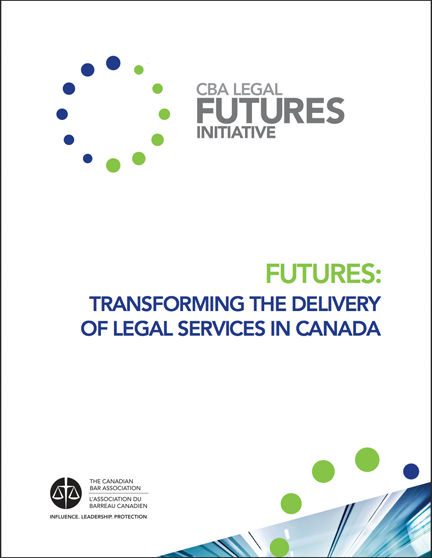ST. JOHN’S — To meet the needs of clients in the 21st century, Canadian law firms will need both capital and innovative ideas from non-lawyers, according to the Canadian Bar Association’s
Futures report, which was unveiled today at the CBA’s legal conference in St. John’s, NL.

The report comes with 22 recommendations for changes across the legal profession aimed at a sustainable future, including a move towards ownership of law firms by non-lawyers through a more liberalized regulatory model.
“Employing a liberalized model would allow the profession to uphold the public policy rationale underlying regulation while welcoming the investment and capital that spurs innovation, allows for global competition, enhances efficiencies, and facilitates new ways of serving clients,” the report states.
The existing regulatory model is neither current nor relevant and puts a limit to the kind of innovation the profession needs in order to meet client needs, according to the report.
“We acknowledge quite clearly that you can only do so much innovation inside a box,” says Fred Headon, the president of the Canadian Bar Association. “We need to find a way to balance the loosening of regulation on one side with new models of regulation that will help us facilitate working with other professionals while maintaining those principles and values that are so important to what we do.”
Different modesl have been tested in Australia and England, says the report, and these countries did not see harm to client representation or public interest.
To ensure the independence of lawyers’ opinion and encourage a more proactive regulation of the profession, the Futures initiative team is recommending law societies regulate entities providing legal services as well as individual lawyers.
“By assigning responsibility for compliance within organizations, there is typically substantive movement towards getting things done,” says the report, which cites a two-third drop in complaints against legal service providers in New South Wales as a persuasive argument for compliance-based regulation.
According to the report, the future of the legal profession will be one in which lawyers work with non-lawyers in law firms, resembling the model of medical offices in which doctors work alongside other professionals.
“The era of exclusive relationships with a lawyer sitting behind a mahogany desk administering expensive advice is coming to a close,” it states.
Other recommendations of the report include:
- Fee sharing between lawyers and non-lawyers: The report encourages fee-sharing and referral fees between lawyers and non-lawyers subject to conflict, privilege, and other rules.
- Include non-lawyer benchers: Law society Convocation benchers should be made up of elected lawyers as well as “a significant number of appointed lawyers and non-lawyers.”
- Reporting on diversity: Law societies should collect data about the demographic composition of all Canadian law firms and publish that data.
- Law school entry and exit data: Law schools should also collect and publish information about the composition of the students entering and leaving their schools, the report says.
- CBA promotion of innovation: The CBA should facilitate innovation incubation, create an innovation chair, and establish innovation awards
Read the full report here and visit Law Times next week for more extensive coverage.

 The report comes with 22 recommendations for changes across the legal profession aimed at a sustainable future, including a move towards ownership of law firms by non-lawyers through a more liberalized regulatory model.
The report comes with 22 recommendations for changes across the legal profession aimed at a sustainable future, including a move towards ownership of law firms by non-lawyers through a more liberalized regulatory model.